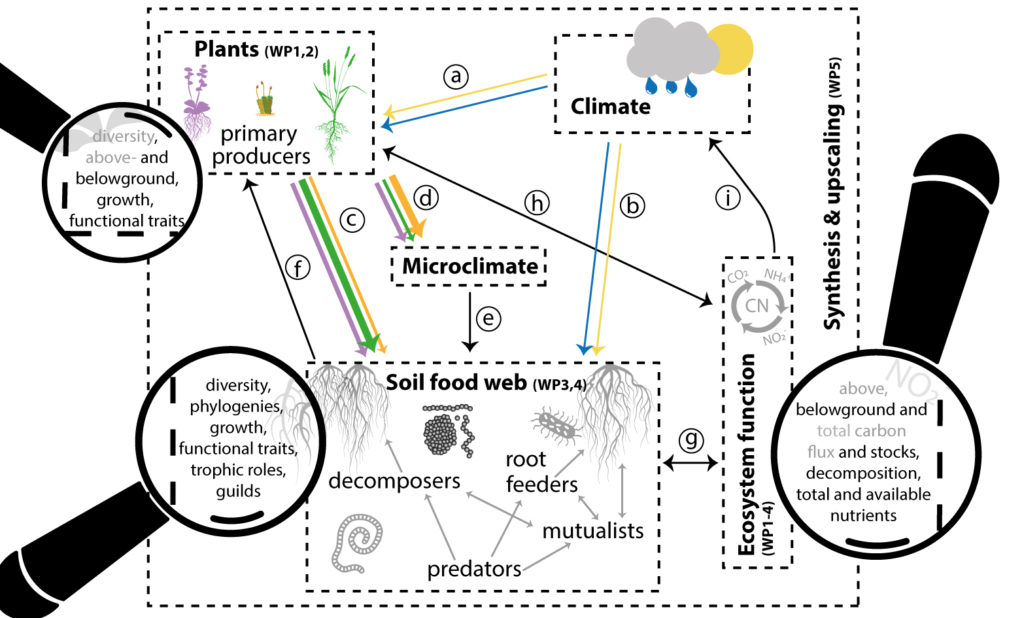FUNDER Direct and indirect climate impacts on the biodiversity and Functioning of the UNDERground ecosystem
Climate change alters plant and soil communities, as well as processes and interactions in the plant-soil food web. These changes pose threats to biodiversity and key ecosystem functions, such as productivity and carbon and nutrient cycling. To predict how biodiversity and ecosystem functioning will respond to future climatic changes, and how these changes will feed back to the climate system, profound knowledge of climate impacts on underlying ecological responses, processes, mechanisms, and interactions in the plant-soil food web is needed.
FUNDER will assess and disentangle the direct effects of climate from the indirect effects, mediated through biotic interactions, on the diversity and whole-ecosystem functioning of the plant−soil food web. To achieve this, we use a powerful macroecological experimental approach to quantify the impacts of vegetation diversity on interactions and ecosystem functioning across factorial broad-scale temperature and precipitation gradients. This will allow us to gain a holistic understanding of ecosystem responses to climate change, including non-additive effects, context-dependencies across landscapes, compensatory effects and climate mismatches that may lead to disruption of biotic interactions.
Towards this end, FUNDER brings together an optimal team of researchers with complementary skills and expertise from five world-class research institutions in Norway and abroad to develop new approaches in global change, ecosystem, conservation ecology and earth system modelling with important applications and benefits for both basic science and applied climate change research. The research is made possible, and provides added value, through exploiting an existing Norwegian experimental infrastructure.
Our objectives are to
- Disentangle direct and indirect climate impacts on plants (WP2), soil nematodes and microarthropods (WP3), and soil microbes (WP4), and ecosystem (WP1-4),
- Understand landscape variation and whole-ecosystem consequences of indirect effects, and
- Understand climate feedbacks of the plant-soil food web (WP5).
The project is divided in five work packages:
- WP1: Maintain field experiments and data infrastructure (Vandvik, Halbritter, Telford
We utilize twelve field sites established in south-western Norway in 2008. The sites were set up in a factorial climate grid where summer temperature (6.5−10.5°C) and annual precipitation (600−2700 mm) vary independently. In 2015, a removal experiment was set up in each of these sites, with fully factorial removal of the dominant PFGs − graminoids, forbs, and bryophytes to disentangle direct and indirect effects of climate on plant diversity and ecosystem carbon cycling.
- WP2: Plant functional traits above- and belowground (Vandvik, Halbritter, Goldberg, PhD1)
We will measure plot-level leaf traits and install root ingrowth cores. After destructive harvesting, we will also quantify root traits and clonal plant traits.
- WP3: Nematodes and microarthropods (Kardol, Wardle, Vandvik, PhD1)
In order to map the soil food web, we will yield information on abundance/biomass and diversity of functional groups (decomposers, consumers, predators, etc.) and of fungal- and bacterial-based energy channels, we will extract, identify and quantify and soil fauna from the soil collected in each plot; nematodes, microarthropods, mites and springtails.
- WP4: Soil bacteria, soil and mycorrhizal fungi (Øvreås, Kauserud, Postdoc)
We will combine the data obtained from the soil nutrients and soil properties analyses with the indigenous soil microbiome including archaea, bacteria, fungi, protists and other microbial eukaryotes. High quality DNA will be extracted from all soil samples and a subset of litter bags. The phylogenetic structure of the soil bacterial and fungal communities. The phylogenetic structure of the soil bacterial and fungal communities will be determined and the DNA will be subjected to PCR for high-throughput sequencing (HTS) library construction. We will also measure mycelial production and investigate which fungal functional groups are responsible for decomposition processes of the varying plant functional types.
- WP5: Synthesis and Climate system implications (Halbritter, Tang, Vandvik, Wardle, PhD2, all)
We will synthesize effects of climate and PFGs on functions and proxies related to nutrient cycling, carbon cycling, plant function, and biodiversity. A multifunctionality approach allows synthetic analysis of different functions across the whole plant-soil food web by averaging standardized effects across responses. We will build on data collected in WP2-4 to improve the description of underground processes in CLM5-FATES38, a state-of-the-art ecosystem model well suited for our purpose as it has a multi-layer soil biochemistry model, a newly-developed demographic vegetation model (FATES), and flexibility in defining and parameterizing plant functional types (PFTs).
- Vigdis Vandvik, University of Bergen
- Lise Øvreås, University of Bergen
- Richard J. Telford, University of Bergen
- Paul Kardol, Swedish Agricultural University
- David Wardle, Nanyang Technological University
- Deborah Goldberg, University of Michigan
- Aud Halbritter, University of Bergen
- Håvard Kauserud, University of Oslo
- Hui Tang, University of Oslo

